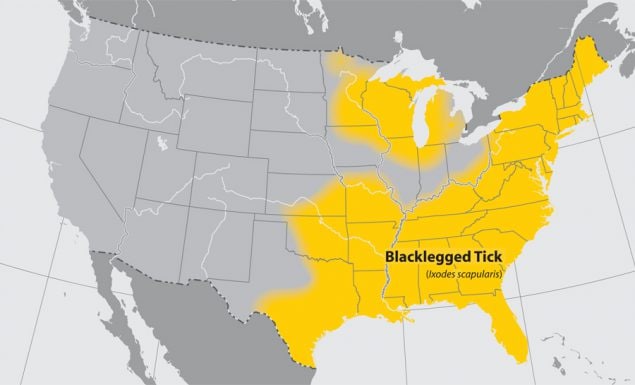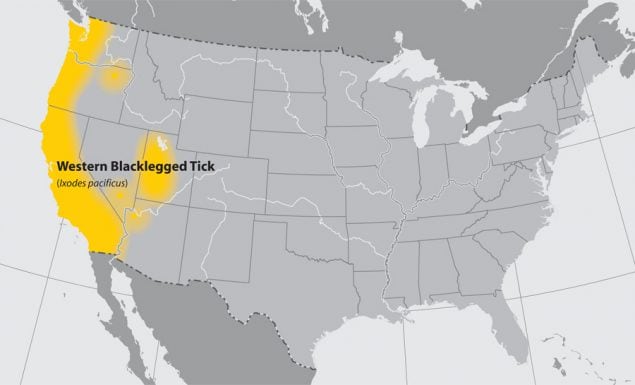Transmission and Epidemiology
Figure 1: Estimated geographic distribution of blacklegged ticks (above) and western blacklegged ticks (below)


Anaplasmosis, also known as human granulocytic anaplasmosis, is a tickborne disease caused by the bacterium Anaplasma phagocytophilum.
Transmission
Tick Bites
- Primarily, through infected tick bites.
- Blacklegged tick (Ixodes scapularis) pdf icon[PDF – 1 page] widely distributed across the eastern United States.
- The blacklegged tick also transmits other pathogens (including Borrelia burgdorferi) in certain geographic areas, and coinfections have been reported.
- Western blacklegged tick (Ixodes pacificus) pdf icon[PDF – 1 page] along the West Coast.
- Blacklegged tick (Ixodes scapularis) pdf icon[PDF – 1 page] widely distributed across the eastern United States.
Less commonly, through blood transfusion and organ transplant
- A. phagocytophilum can be transmitted through blood transfusions.
- A. phagocytophilum has been shown to survive for more than a week in refrigerated blood.
- Several cases of transfusion-transmitted anaplasmosis have been reported, including in cases of asymptomatic donors.
- Patients who develop anaplasmosis within a month of receiving a blood transfusion or solid organ transplant should be reported to state health officials for prompt investigation.
- Leukoreduction might reduce the risk of Anaplasma transmission; but it does not eliminate it. Cases associated with the use of leukoreduced blood products have been documented.
- Blood products are not routinely screened for the presence of A. phagocytophilum.
- For more information about anaplasmosis and blood transfusions see the Special Considerations section of: Diagnosis and Management of Tickborne Rickettsial Diseases: Rocky Mountain Spotted Fever and Other Spotted Fever Group Rickettsioses, Ehrlichioses, and Anaplasmosis — United States: A Practical Guide for Health Care and Public Health Professionals (2016) pdf icon[PDF – 48 pages]
Epidemiology
Figure 2: Incidence (per million population) for anaplasmosis, United States, 2017.

Geographic range: Anaplasmosis is most commonly reported in the Northeastern and upper Midwestern states, although the geographic range of anaplasmosis cases appears to be expanding.
- Peak transmission: Most cases occur during June–November. Two peaks of increased case reporting usually occur, with the first peak during June–July and a smaller peak during October-November.
- For more information, see: Seasonality
Page last reviewed: January 11, 2019